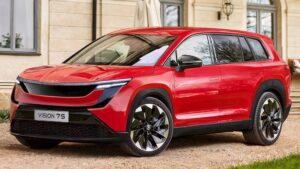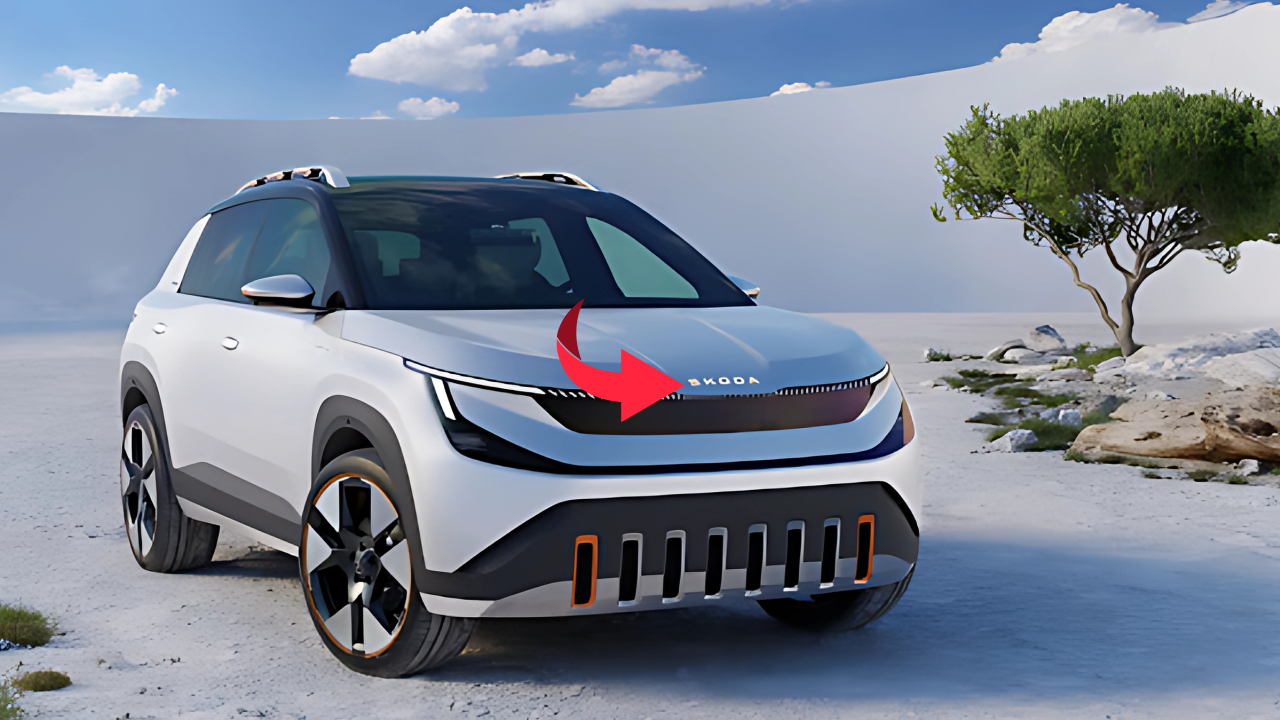Skoda, the Czech automaker under the Volkswagen Group umbrella, is making significant strides in expanding its electric vehicle (EV) and plug-in hybrid electric vehicle (PHEV) offerings in Australia. With the recent confirmation that the Skoda Epiq and Vision 7S electric SUVs are set to arrive in the Australian market by 2027, and with PHEV variants of the Superb and Kodiaq currently undergoing local testing, Skoda is positioning itself as a key player in Australia’s rapidly evolving automotive landscape. This article delves into the details of these upcoming models, their significance for Australian consumers, and Skoda’s broader strategy in the electric and hybrid vehicle market.
Skoda Epiq: The Compact Electric SUV
The Skoda Epiq is poised to become the brand’s smallest electric SUV, designed to appeal to urban drivers seeking a compact yet practical vehicle. Unveiled as a concept in March 2024, the Epiq is expected to enter production in 2026, with an Australian launch targeted for 2027. Measuring approximately 4.1 meters in length, the Epiq is significantly shorter than its siblings, the Elroq (4.5 meters) and Enyaq, making it an ideal choice for city driving and parking. Despite its compact dimensions, the Epiq promises class-leading practicality, boasting a boot capacity of 490 liters—surpassing even the larger Elroq’s 470 liters.
The Epiq’s design draws heavily from Skoda’s “Modern Solid” philosophy, featuring a sleek, minimalist aesthetic with stacked headlights, distinctive daytime running lights, and a gloss-black “Tick Deck” front panel housing advanced driver assistance system (ADAS) radars. The concept model showcased a modern interior with a 5.3-inch digital driver’s display, a 13-inch central touchscreen infotainment system, and a two-spoke steering wheel, all of which are likely to carry over to the production model. A row of physical buttons beneath the touchscreen ensures easy access to essential functions like climate control and driving assists, blending digital innovation with practical usability.
Underpinning the Epiq is the Volkswagen Group’s MEB-Small platform, shared with the upcoming Volkswagen ID.2 and Cupra Raval. This platform supports battery options of 38 kWh and 56 kWh, with the Epiq expected to deliver a range of up to 450 km in its most efficient configuration—exceeding the entry-level ranges of competitors like the BYD Dolphin and MG4 EV. The Epiq will also feature Vehicle-to-Load (V2L) and Vehicle-to-Vehicle (V2V) capabilities, allowing it to power external devices or charge other EVs, enhancing its versatility for Australian consumers.
Skoda aims to price the Epiq competitively, with estimates suggesting a starting price of around £21,000–£25,000 (approximately AUD 40,000–47,000). This positions the Epiq as a strong contender against budget-friendly rivals like the Citroen e-C3, BYD Atto 2, and premium options such as the MINI Aceman and Volvo EX30. Its combination of affordability, practicality, and modern design makes it a compelling option for Australian buyers looking to transition to electric mobility.

Vision 7S: The Flagship Seven-Seater
In contrast to the compact Epiq, the Skoda Vision 7S is set to become the brand’s flagship electric SUV, offering seating for seven and a premium driving experience. Based on the Vision 7S concept unveiled in 2023, this model is also slated for an Australian launch in 2027. The production version will retain the concept’s angular, robust styling, aligning with Skoda’s “Modern Solid” design language and sharing visual cues with the Epiq, such as its bold front fascia and minimalist aesthetic.
The Vision 7S is expected to utilize a larger battery, likely an 89 kWh unit, delivering a range of approximately 373 miles (600 km) based on the concept’s specifications. This extended range makes it suitable for long-distance travel, a critical factor for Australian consumers who often navigate vast distances. The Vision 7S will also leverage the Volkswagen Group’s MEB platform, tailored for larger vehicles, ensuring robust performance and efficiency.
Inside, the Vision 7S concept featured a spacious, family-oriented cabin with a flexible seating arrangement and premium materials. While specific details about the production model’s interior are yet to be confirmed, Skoda’s focus on practicality suggests ample cargo space and versatile configurations to accommodate families and their gear. The Vision 7S is positioned as a premium offering, competing with models like the Tesla Model Y and Volvo EX90, and is expected to appeal to buyers seeking a spacious, eco-friendly SUV for both urban and regional use.
PHEV Models: Superb and Kodiaq in Testing
In addition to its electric SUVs, Skoda Australia is actively testing plug-in hybrid variants of the Superb sedan/wagon and Kodiaq seven-seater SUV, with a potential launch in early 2026. These models aim to bridge the gap between traditional internal combustion engine (ICE) vehicles and fully electric options, catering to fleet buyers, families, and consumers hesitant to fully commit to EVs due to range anxiety or infrastructure concerns.
The Superb PHEV combines a 1.5-liter petrol engine with an electric motor, offering an electric-only range of over 100 km and significantly reduced fuel consumption. Similarly, the Kodiaq PHEV is expected to adopt the same powertrain, providing a practical solution for families needing a versatile seven-seater with lower emissions. These models are being evaluated for Australian conditions, ensuring they meet local demands for performance, efficiency, and durability. However, their introduction remains under consideration, with final decisions pending the outcome of testing.
The decision to introduce PHEVs reflects Skoda’s pragmatic approach to electrification. While EVs like the Epiq and Vision 7S represent the future, PHEVs offer a transitional solution, particularly in Australia, where charging infrastructure is still developing, and long-distance driving is common. The Superb and Kodiaq PHEVs are likely to appeal to fleet operators and families, with Skoda Australia targeting police forces and corporate buyers with the Superb in particular.
Skoda’s Electrification Strategy in Australia
Skoda’s push into electric and hybrid vehicles aligns with Australia’s growing demand for low-emission transport, driven by stricter emissions regulations and consumer interest in sustainable mobility. The Australian new-car market saw a 117.6% increase in PHEV sales in May 2025, despite a decline in overall vehicle sales, indicating strong interest in hybrid technologies. However, PHEV sales have faced challenges due to the end of Fringe Benefits Tax exemptions, highlighting the need for competitive pricing and compelling features.
Skoda’s strategy focuses on offering a diverse portfolio, from affordable compact EVs like the Epiq to premium, family-oriented models like the Vision 7S. The inclusion of PHEVs demonstrates Skoda’s understanding of Australia’s unique market dynamics, where long distances and limited charging infrastructure can make hybrids a more practical choice for some buyers. By leveraging the Volkswagen Group’s MEB platform and shared technologies, Skoda can deliver cost-effective, high-quality vehicles that meet global standards while catering to local needs.
The Epiq and Vision 7S also underscore Skoda’s commitment to affordability and practicality. The Epiq’s competitive pricing and generous boot space make it an attractive entry-level EV, while the Vision 7S targets buyers seeking a premium, spacious SUV. Meanwhile, the Superb and Kodiaq PHEVs offer a middle ground, combining electric efficiency with the flexibility of a petrol engine. This multi-pronged approach positions Skoda to capture a broad segment of the Australian market, from budget-conscious urbanites to families and fleet operators.
Competitive Landscape
The Australian EV and PHEV market is becoming increasingly competitive, with brands like BYD, Tesla, Volvo, and Kia offering strong alternatives. The BYD Sealion 6 was the top-selling PHEV in Australia in 2024, while the Tesla Model Y remains a benchmark for electric SUVs. Skoda’s Epiq will face direct competition from models like the Citroen e-C3, BYD Atto 2, MINI Aceman, and Volvo EX30, all of which target the compact EV segment. The Vision 7S, meanwhile, will compete with premium offerings like the Tesla Model Y and Volvo EX90.
Skoda’s advantage lies in its reputation for practicality, value, and robust build quality. The Epiq’s 490-liter boot and the Vision 7S’s seven-seat configuration set them apart in their respective segments. Additionally, Skoda’s use of the proven MEB platform ensures reliability and access to cutting-edge EV technology. The PHEV models, if launched, will compete with vehicles like the Mitsubishi Outlander PHEV and the upcoming Geely Starray EM-i, offering Australian buyers a diverse range of options.
Comparison Table: Skoda Epiq vs. Vision 7S vs. Competitors
|
Model |
Type |
Length |
Battery/Range |
Boot Space |
Seating |
Est. Price (AUD) |
Launch Year |
|---|---|---|---|---|---|---|---|
|
Skoda Epiq |
Electric SUV |
4.1 m |
38/56 kWh, ~450 km |
490 L |
5 | ~40,000–47,000 | 2027 |
|
Skoda Vision 7S |
Electric SUV |
~4.8 m |
89 kWh, ~600 km |
TBD |
7 |
TBD |
2027 |
|
BYD Atto 2 |
Electric SUV |
~4.0 m |
~45 kWh, ~400 km |
~400 L |
5 | ~40,000 | 2026 |
|
Volvo EX30 |
Electric SUV |
4.2 m |
69 kWh, ~460 km |
318 L |
5 | ~59,000 | 2024 |
|
Mitsubishi Outlander PHEV |
PHEV SUV |
4.7 m |
20 kWh, ~84 km (electric) |
478 L |
7 | ~57,990 |
Available |
Looking Ahead
Skoda’s confirmation of the Epiq and Vision 7S for Australia, alongside the testing of Superb and Kodiaq PHEVs, signals a bold step toward electrification in one of the world’s most challenging automotive markets. The Epiq’s compact size, impressive range, and competitive pricing make it a game-changer for urban buyers, while the Vision 7S caters to families seeking a premium, long-range SUV. The PHEV models, if approved, will provide a practical bridge for consumers transitioning to electrified vehicles. With its focus on affordability, practicality, and advanced technology, Skoda is well-positioned to make a significant impact in Australia’s EV and PHEV landscape by 2027.
